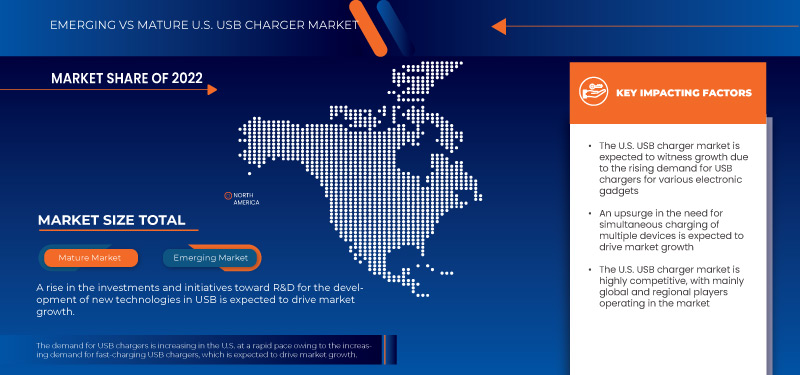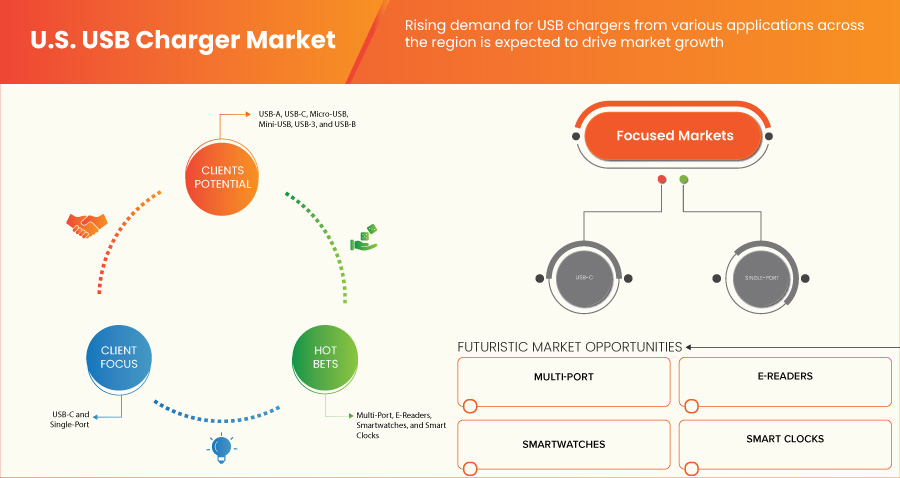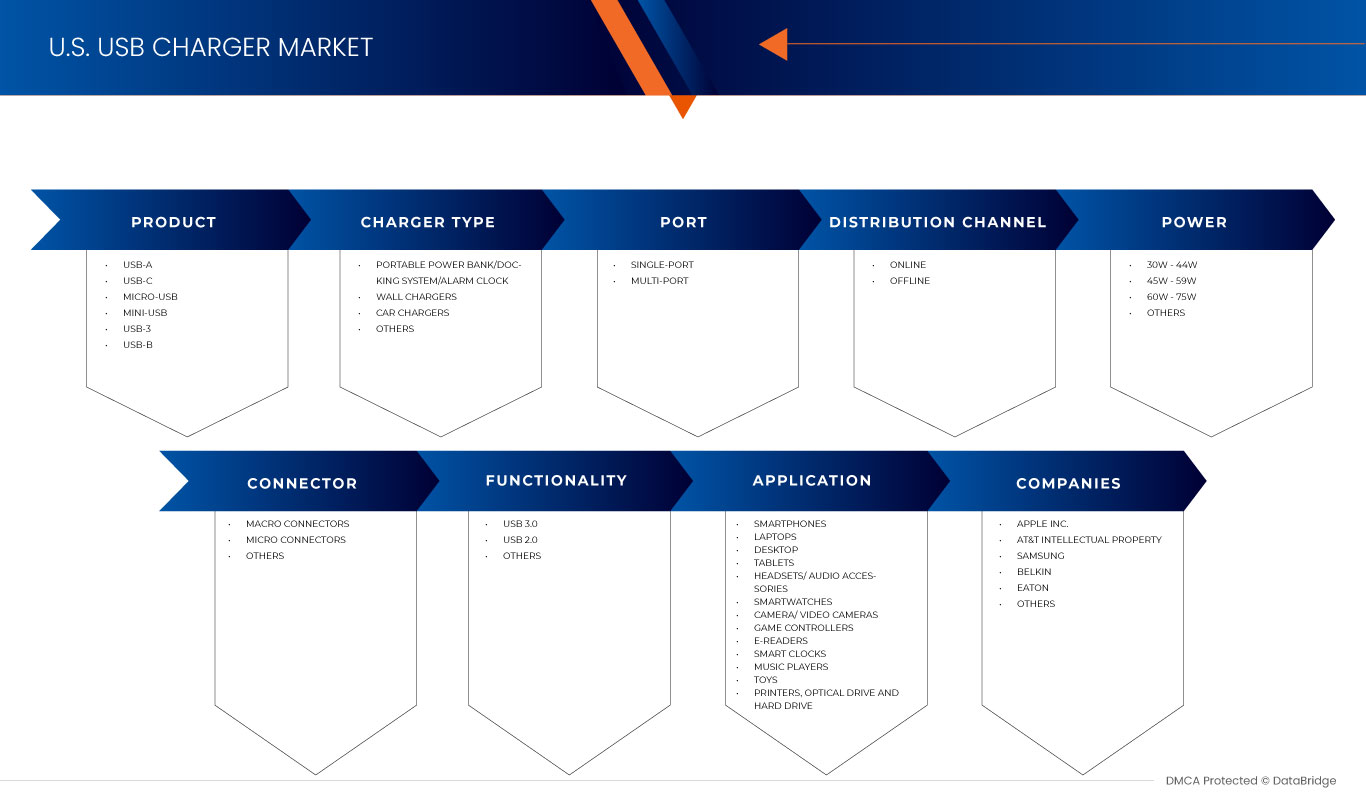미국 USB 충전기 시장, 제품별(USB-A, USB-C, Micro-USB, Mini-USB, USB-3 및 USB-B), 충전기 유형(휴대용 전원 은행/도킹 시스템/알람 시계, 벽면 충전기, 차량용 충전기 및 기타), 포트(단일 포트 및 다중 포트), 유통 채널(온라인 및 오프라인), 전원(30W-44W, 45W-59W, 60W-75W 및 기타), 커넥터(매크로 커넥터, 마이크로 커넥터 및 기타), 기능(USB 2.0, USB 3.0 및 기타), 응용 분야(스마트폰, 노트북, 데스크탑, 태블릿, 헤드셋/오디오 액세서리, 스마트워치 , 카메라/비디오 카메라, 게임 컨트롤러, 전자책 리더, 스마트 시계, 음악 플레이어, 장난감, 프린터, 광학 드라이브 및 하드 드라이브 및 기타) - 업계 동향 및 2030년까지의 예측.
미국 USB 충전기 시장 분석 및 규모
스마트폰 수요 증가는 시장 성장을 촉진할 것으로 예상됩니다. 또한 여러 기기를 동시에 충전해야 하는 필요성이 증가하고 인증 USB 충전기에 대한 수요가 증가함에 따라 시장 성장이 더욱 촉진될 것으로 예상됩니다. 시장에 부정적인 영향을 미칠 수 있는 주요 제약은 위조 제품의 증가입니다. 더 나은 경험을 위한 강화된 R&D 활동은 시장 성장의 기회를 제공할 것으로 예상됩니다. 그러나 기기 단편화와 호환성 문제는 시장 성장에 어려움을 줄 것으로 예상됩니다.
미국 USB 충전기 시장은 2023년에서 2030년의 예측 기간 동안 상당히 성장할 것으로 예상됩니다. Data Bridge Market Research는 시장이 2023년에서 2030년의 예측 기간 동안 6.2%의 CAGR로 성장하고 있으며 2030년까지 11,032.46백만 달러에 도달할 것으로 예상된다고 분석했습니다. 인증 USB 충전기에 대한 수요 증가와 스마트폰 사용 증가는 시장 성장을 견인할 것으로 예상되는 주요 요인입니다.
|
보고서 메트릭 |
세부 |
|
예측 기간 |
2023년부터 2030년까지 |
|
기준 연도 |
2022 |
|
역사적 연도 |
2021 (2015-2020까지 사용자 정의 가능) |
|
양적 단위 |
수익 (단위: USD 백만) |
|
다루는 세그먼트 |
제품(USB-A, USB-C, Micro-USB, Mini-USB, USB-3, USB-B), 충전기 유형(휴대용 전원 은행/도킹 시스템/알람 시계, 벽면 충전기, 차량용 충전기 등), 포트(단일 포트 및 다중 포트), 유통 채널(온라인 및 오프라인), 전원(30W-44W, 45W-59W, 60W-75W 등), 커넥터(매크로 커넥터, 마이크로 커넥터 등), 기능(USB 2.0, USB 3.0 등), 애플리케이션(스마트폰, 노트북, 데스크탑, 태블릿 , 헤드셋/오디오 액세서리, 스마트워치, 카메라/비디오 카메라, 게임 컨트롤러, 전자책 리더, 스마트 시계, 음악 플레이어, 장난감, 프린터, 광학 드라이브 및 하드 드라이브 등) |
|
적용 국가 |
우리를 |
|
시장 참여자 포함 |
Goal Zero, J5create, MIZCO International Limited, myCharge, Nekteck, Ravpower, Spigen, Inc., Native Union, Belkin, ZAGG Inc., Fantasia Trading LLC, Apple Inc., Eaton, SAMSUNG, AT&T Intellectual Property 등 |
시장 정의
A Universal Serial Bus (USB) is a plug-and-play interface that allows computers to communicate with peripherals and other devices. USB-connected devices cover a broad range of keyboards and mice, music players, and flash drives. USB is used to send power to the devices, such as powering smartphones and tablets and charging their batteries. A power adapter that generates the 5-volt DC standard is required by USB. The amperage varies typically from .07A to 2.4A. The charger is plugged into an AC outlet, while a USB cable is plugged into the charger. USB ports on computers have an upper limit of up to 500 milliamps; however, USB chargers that come with cellphones and other devices handle the current of one or more amps.
U.S. USB Charger Market Dynamics
This section deals with understanding the market drivers, restraints, opportunities, and challenges. All of this is discussed in detail below:
Drivers
- Upsurge in the Need for Simultaneous Charging of Multiple Devices
Demand for USB wall chargers is rising very rapidly due to the short battery lives of the electronic devices. Also, people wants to charge all their electronic devices at the same time in order to utilize their time. This has risen the demand of multiport charger market as it is known to be a compact, and a convenient solution and is also very productive in every day’s life. It has also been witnessed that not only traveler but even entertainment, work and others too can use the multiport which helps them to charge its multiple devices at a fast rate. Thus, due to the increase in demand, many companies has come up with different multiport charger. The charger now contains two to seven ports in it which can help the customers to charge all their electronic devices at the same time.
Thus, an increase in the demand for multiport chargers will definitely cater to the need for charging multiple devices such as smartphones, laptops, and others at the same time and at fast rate, which is expected to drive market growth.
- Growing Demand for Certified USB Chargers
People are opting for a certified charger in the market as they are becoming aware of the advantages of certified products over fake chargers. This charger comes not only with good quality but with safety and protection making people opt for certified chargers, which leads to a rise in its demand in the market. Many companies are trying to get the USB IF certification to prove their product is of high quality and safe to use. Also, USB-IF cable certification program aims to provide USB end users with a list of cables that meet the quality standards necessary to operate in a USB environment. Moreover, many companies try for Qi certification as Qi-certified products are tested to international regulatory standards to increase safety, assure quality, reduce risk, prove interoperability, and ensure reliability.
Customers demand certified products to ensure product quality and safety, which is expected to drive market growth.
Opportunity
- Expansion in Demand for Fast Charging Charger in the Market
People nowadays have a fast life due to which they do not have much time to spare charging their devices, which leads to the increase in demand for fast-charging technology in the market. Many new technologies such as USB PD technology, USB 4.0, and others are developing which will help the consumer to charge his device in less time and carry on his work. Many companies are incorporating new and advanced technology in their charging solutions to cater to the rising demand of the market.
Thus, with the advancement in charging technology, companies can provide their consumers with fast chargers which will be safer and more efficient. This is expected to drive market growth.
Restraint
- Increase in the Presence of Counterfeit Products
The rise in the presence of fake products in the USB charger market is a significant concern for consumers, manufacturers, and regulatory bodies alike. Fake or counterfeit USB chargers refer to those products that imitate the appearance and branding of genuine chargers but often do not meet the safety, quality, and performance standards established by regulatory authorities. This issue has become more prevalent with the increasing demand for electronic devices and accessories. The manufacturing and distribution of electronic accessories including USB chargers can be subject to limited regulations and oversight in certain regions. This regulatory gap provides an opportunity for counterfeiters to exploit the market. Many companies are creating structurally similar products and selling them as real ones. But the quality of such product is very low which hamper the consumer and their devices. Fake product also damages the brand image of the company in the market. Counterfeit chargers often lack proper safety mechanisms, leading to a higher risk of electrical accidents, overheating, fires, and even electric shocks. The use of substandard components can result in serious safety issues. Poor-quality chargers can damage electronic devices by delivering incorrect voltage or current levels, leading to reduced battery life, performance issues, or complete device failure. Adding to this, their presence can decrease the total sales of the company.
Manufacturers, governments, and regulatory bodies also play a crucial role in combating the presence of fake products in the market. They can work together to establish and enforce stricter regulations to enhance product traceability and conduct regular market surveillance to make consumers aware of the risks associated with counterfeit products.
Challenge
- Device Fragmentation and Compatibility Issues
Device fragmentation specially refers to the wide range of devices with different charging requirements, connector types, and compatibility issues that manufacturers and consumers have to deal with while manufacturing. Different devices use various types of USB connectors such as USB-A, USB-C, and micro USB. These connectors have varying physical designs and capabilities, leading to the need for different types of chargers and cables. Devices have different battery capacities and power consumption levels. Some devices like smartphones and tablets require less power to charge, while laptops and others need higher wattages for efficient charging. Consumers need to navigate a complex landscape of charging options to find chargers that are compatible with their devices and provide the desired charging speeds.
Recent Developments
- In 2021, Spigen Inc. extended its range of ‘ArcStation Pro’ GaN-based fast chargers and introduced GaNFast 45W ArcStation Pro charger especially for Samsung’s flagship smartphone, the S21 Ultra. GaN, a next-generation semiconductor technology, is used in the charger that runs up to 100x faster than old, slow silicon (Si) and enables up to 3x more power or 3x faster charging in half the size & weight. In addition, it has dual USB-C outputs, which will help charge two devices at the same time. Thus, the company will be able to provide its customers with another fast multi-port charger
- In 2021, Belkin launched two new products SoundForm true wireless earbuds and a MagSafe compatible BoostCharge Pro Wireless charger. This charger has a quick charge feature, which gives 2 hours of playback with just 15 minutes of charging. Thus, the company has brought forward another fast wireless charger for its customers
U.S. USB Charger Market Scope
The U.S. USB charger market is segmented into eight notable segments based on product, charger type, port, distribution channel, power, connector, functionality, and application. The growth amongst these segments will help you analyze major growth segments in the industries and provide the users with a valuable market overview and market insights to make strategic decisions to identify core market applications.
Product
- USB-A
- USB-C
- Micro-USB
- Mini-USB
- USB-3
- USB-B
On the basis of product, the market is segmented into USB-A, USB-C, Micro-USB, Mini-USB, USB-3, and USB-B.
Charger Type
- Portable Power Bank/Docking System/Alarm Clock
- Wall Chargers
- Car Chargers
- Others
On the basis of charger type, the market is segmented into portable power bank/docking system/alarm clock, wall chargers, car chargers, and others.
Port
- Single Port
- Multi-Port
On the basis of port, the market is segmented into single port and multi-port.
Distribution Channel
- Online
- Offline
On the basis of distribution channel, the market is segmented into online and offline.
Power
- 30W-44W
- 45W-59W
- 60W-75W
- Others
On the basis of power, the market is segmented into 30W-44W, 45W-59W, 60W-75W, and others.
Connector
- Macro Connectors
- Micro Connectors
- Others
커넥터를 기준으로 시장은 매크로 커넥터, 마이크로 커넥터 및 기타로 구분됩니다.
기능성
- USB 2.0
- USB 3.0
- 기타
기능은 USB 2.0, USB 3.0 등으로 구분됩니다.
애플리케이션
- 스마트폰
- 노트북
- 데스크탑
- 정제
- 헤드셋/오디오 액세서리
- 스마트워치
- 카메라/비디오 카메라
- 게임 컨트롤러
- 전자책 리더기
- 스마트 시계
- 음악 플레이어
- 장난감
- 프린터
- 광학 드라이브 및 하드 드라이브
- 기타
시장은 응용 프로그램을 기준으로 스마트폰, 노트북, 데스크탑, 태블릿, 헤드셋/오디오 액세서리, 스마트워치, 카메라/비디오 카메라, 게임 컨트롤러, 전자책 리더, 스마트 시계, 음악 플레이어, 장난감, 프린터, 광학 드라이브 및 하드 드라이브 등으로 구분됩니다.
경쟁 환경 및 미국 USB 충전기 시장 점유율 분석
USB 충전기 시장 경쟁 구도는 경쟁자에 대한 세부 정보를 제공합니다. 포함된 세부 정보는 회사 개요, 회사 재무, 창출된 수익, 시장 잠재력, 연구 개발 투자, 새로운 시장 이니셔티브, 생산 현장 및 시설, 회사의 강점과 약점, 제품 출시, 제품 시험 파이프라인, 제품 승인, 특허, 제품 폭과 폭, 응용 프로그램 우세, 기술 수명선 곡선입니다. 제공된 위의 데이터 포인트는 USB 충전기 시장과 관련된 회사의 초점에만 관련이 있습니다.
시장에서 활동하는 주요 시장 주체로는 Goal Zero, J5create, MIZCO International Limited, myCharge, Nekteck, Ravpower, Spigen, Inc., Native Union, Belkin, ZAGG Inc., Fantasia Trading LLC, Apple Inc., Eaton, SAMSUNG, AT&T Intellectual Property 등이 있습니다.
SKU-
세계 최초의 시장 정보 클라우드 보고서에 온라인으로 접속하세요
- 대화형 데이터 분석 대시보드
- 높은 성장 잠재력 기회를 위한 회사 분석 대시보드
- 사용자 정의 및 질의를 위한 리서치 분석가 액세스
- 대화형 대시보드를 통한 경쟁자 분석
- 최신 뉴스, 업데이트 및 추세 분석
- 포괄적인 경쟁자 추적을 위한 벤치마크 분석의 힘 활용
목차
1 INTRODUCTION
1.1 OBJECTIVES OF THE STUDY
1.2 MARKET DEFINITION
1.3 OVERVIEW
1.4 LIMITATIONS
1.5 MARKETS COVERED
2 MARKET SEGMENTATION
2.1 MARKETS COVERED
2.2 GEOGRAPHICAL SCOPE
2.3 YEARS CONSIDERED FOR THE STUDY
2.4 CURRENCY AND PRICING
2.5 DBMR TRIPOD DATA VALIDATION MODEL
2.6 PRODUCT LIFELINE CURVE
2.7 MULTIVARIATE MODELING
2.8 PRIMARY INTERVIEWS WITH KEY OPINION LEADERS
2.9 DBMR MARKET POSITION GRID
2.1 DBMR APPLICATION COVERAGE GRID
2.11 DBMR VENDOR SHARE ANALYSIS
2.12 SECONDARY SOURCES
2.13 ASSUMPTIONS
3 EXECUTIVE SUMMARY
4 PREMIUM INSIGHTS
5 ADDITIONAL CUSTOMIZATION
5.1 MARKET SHARE ANALYSIS: BY PRODUCT (2022)
5.2 MARKET SHARE ANALYSIS (2022)
6 MARKET OVERVIEW
6.1 DRIVERS
6.1.1 UPSURGE IN THE NEED FOR SIMULTANEOUS CHARGING OF MULTIPLE DEVICES
6.1.2 GROWING DEMAND FOR CERTIFIED USB CHARGERS
6.1.3 INCREASING DEMAND FOR SMARTPHONES
6.2 RESTRAINT
6.2.1 INCREASE IN THE PRESENCE OF COUNTERFEIT PRODUCTS
6.3 OPPORTUNITIES
6.3.1 ENHANCED RESEARCH AND DEVELOPMENT ACTIVITIES FOR BETTER PRODUCT EXPERIENCE AND RISING DEMAND FOR WIRELESS CHARGERS
6.3.2 EXPANSION IN DEMAND FOR FAST CHARGING CHARGERS IN THE MARKET
6.4 CHALLENGE
6.4.1 DEVICE FRAGMENTATION AND COMPATIBILITY ISSUES
7 U.S. USB CHARGER MARKET: COMPANY LANDSCAPE
7.1 COMPANY SHARE ANALYSIS: U.S.
7.2 NEW PRODUCT LAUNCHES
7.3 PARTNERSHIP
7.4 RECOGNITION
8 SWOT ANALYSIS
9 COMPANY PROFILES
9.1 APPLE INC.
9.1.1 COMPANY SNAPSHOT
9.1.2 REVENUE ANALYSIS
9.1.3 PRODUCT PORTFOLIO
9.1.4 RECENT DEVELOPMENT
9.2 AT&T INTELLECTUAL PROPERTY
9.2.1 COMPANY SNAPSHOT
9.2.2 REVENUE ANALYSIS
9.2.3 PRODUCT PORTFOLIO
9.2.4 RECENT DEVELOPMENTS
9.3 SAMSUNG
9.3.1 COMPANY SNAPSHOT
9.3.2 REVENUE ANALYSIS
9.3.3 PRODUCT PORTFOLIO
9.3.4 RECENT DEVELOPMENTS
9.4 BELKIN
9.4.1 COMPANY SNAPSHOT
9.4.2 PRODUCT PORTFOLIO
9.4.3 RECENT DEVELOPMENTS
9.5 EATON
9.5.1 COMPANY SNAPSHOT
9.5.2 REVENUE ANALYSIS
9.5.3 PRODUCT PORTFOLIO
9.5.4 RECENT DEVELOPMENTS
9.6 FANTASIA TRADING LLC
9.6.1 COMPANY SNAPSHOT
9.6.2 PRODUCT PORTFOLIO
9.6.3 RECENT DEVELOPMENTS
9.7 GOAL ZERO
9.7.1 COMPANY SNAPSHOT
9.7.2 PRODUCT PORTFOLIO
9.7.3 RECENT DEVELOPMENT
9.8 J5CREATE
9.8.1 COMPANY SNAPSHOT
9.8.2 PRODUCT PORTFOLIO
9.8.3 RECENT DEVELOPMENTS
9.9 MIZCO INTERNATIONAL INC
9.9.1 COMPANY SNAPSHOT
9.9.2 PRODUCT PORTFOLIO
9.9.3 RECENT DEVELOPMENTS
9.1 MYCHARGE
9.10.1 COMPANY SNAPSHOT
9.10.2 PRODUCT PORTFOLIO
9.10.3 RECENT DEVELOPMENTS
9.11 NATIVE UNION
9.11.1 COMPANY SNAPSHOT
9.11.2 PRODUCT PORTFOLIO
9.11.3 RECENT DEVELOPMENTS
9.12 NEKTECK
9.12.1 COMPANY SNAPSHOT
9.12.2 PRODUCT PORTFOLIO
9.12.3 RECENT DEVELOPMENT
9.13 RAVPOWER (A SUBSIDIARY OF SUNVALLEYTEK LIMITED)
9.13.1 COMPANY SNAPSHOT
9.13.2 PRODUCT PORTFOLIO
9.13.3 RECENT DEVELOPMENTS
9.14 SPIGEN,INC.
9.14.1 COMPANY SNAPSHOT
9.14.2 PRODUCT PORTFOLIO
9.14.3 RECENT DEVELOPMENTS
9.15 ZAGG INC.
9.15.1 COMPANY SNAPSHOT
9.15.2 PRODUCT PORTFOLIO
9.15.3 RECENT DEVELOPMENTS
10 QUESTIONNAIRE
11 RELATED REPORTS
그림 목록
FIGURE 1 U.S. USB CHARGER MARKET: SEGMENTATION
FIGURE 2 U.S. USB CHARGER MARKET: DATA TRIANGULATION
FIGURE 3 U.S. USB CHARGER MARKET: DROC ANALYSIS
FIGURE 4 U.S. USB CHARGER MARKET: COUNTRY VS REGIONAL MARKET ANALYSIS
FIGURE 5 U.S. USB CHARGER MARKET: COMPANY RESEARCH ANALYSIS
FIGURE 6 U.S. USB CHARGER MARKET: THE PRODUCT LIFE LINE CURVE
FIGURE 7 U.S. USB CHARGER MARKET: MULTIVARIATE MODELLING
FIGURE 8 U.S. USB CHARGER MARKET: INTERVIEW DEMOGRAPHICS
FIGURE 9 U.S. USB CHARGER MARKET: DBMR MARKET POSITION GRID
FIGURE 10 U.S. USB CHARGER MARKET: APPLICATION COVERAGE GRID
FIGURE 11 U.S. USB CHARGER MARKET: VENDOR SHARE ANALYSIS
FIGURE 12 U.S. USB CHARGER MARKET: SEGMENTATION
FIGURE 13 THE INCREASING DEMAND FOR SMARTPHONES IS EXPECTED TO DRIVE THE GROWTH OF THE U.S. USB CHARGER MARKET IN THE FORECAST PERIOD
FIGURE 14 THE USB-C SEGMENT IS EXPECTED TO ACCOUNT FOR THE LARGEST MARKET SHARE OF THE U.S. USB CHARGER MARKET IN 2023 AND 2030
FIGURE 15 DRIVERS, RESTRAINTS, OPPORTUNITIES, AND CHALLENGES OF THE U.S. USB CHARGER MARKET
FIGURE 16 U.S. USB CHARGER MARKET: COMPANY SHARE 2022 (%)
연구 방법론
데이터 수집 및 기준 연도 분석은 대규모 샘플 크기의 데이터 수집 모듈을 사용하여 수행됩니다. 이 단계에는 다양한 소스와 전략을 통해 시장 정보 또는 관련 데이터를 얻는 것이 포함됩니다. 여기에는 과거에 수집한 모든 데이터를 미리 검토하고 계획하는 것이 포함됩니다. 또한 다양한 정보 소스에서 발견되는 정보 불일치를 검토하는 것도 포함됩니다. 시장 데이터는 시장 통계 및 일관된 모델을 사용하여 분석하고 추정합니다. 또한 시장 점유율 분석 및 주요 추세 분석은 시장 보고서의 주요 성공 요인입니다. 자세한 내용은 분석가에게 전화를 요청하거나 문의 사항을 드롭하세요.
DBMR 연구팀에서 사용하는 주요 연구 방법론은 데이터 마이닝, 시장에 대한 데이터 변수의 영향 분석 및 주요(산업 전문가) 검증을 포함하는 데이터 삼각 측량입니다. 데이터 모델에는 공급업체 포지셔닝 그리드, 시장 타임라인 분석, 시장 개요 및 가이드, 회사 포지셔닝 그리드, 특허 분석, 가격 분석, 회사 시장 점유율 분석, 측정 기준, 글로벌 대 지역 및 공급업체 점유율 분석이 포함됩니다. 연구 방법론에 대해 자세히 알아보려면 문의를 통해 업계 전문가에게 문의하세요.
사용자 정의 가능
Data Bridge Market Research는 고급 형성 연구 분야의 선두 주자입니다. 저희는 기존 및 신규 고객에게 목표에 맞는 데이터와 분석을 제공하는 데 자부심을 느낍니다. 보고서는 추가 국가에 대한 시장 이해(국가 목록 요청), 임상 시험 결과 데이터, 문헌 검토, 재생 시장 및 제품 기반 분석을 포함하도록 사용자 정의할 수 있습니다. 기술 기반 분석에서 시장 포트폴리오 전략에 이르기까지 타겟 경쟁업체의 시장 분석을 분석할 수 있습니다. 귀하가 원하는 형식과 데이터 스타일로 필요한 만큼 많은 경쟁자를 추가할 수 있습니다. 저희 분석가 팀은 또한 원시 엑셀 파일 피벗 테이블(팩트북)로 데이터를 제공하거나 보고서에서 사용 가능한 데이터 세트에서 프레젠테이션을 만드는 데 도움을 줄 수 있습니다.









